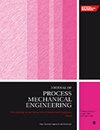Breaking boundaries: Optimizing dry machining for AISI D4 hardened tool steel through hybrid ceramic tool inserts
IF 2.2
4区 工程技术
Q2 ENGINEERING, MECHANICAL
Proceedings of the Institution of Mechanical Engineers, Part E: Journal of Process Mechanical Engineering
Pub Date : 2024-07-26
DOI:10.1177/09544089241265036
引用次数: 0
Abstract
The conventional approach to high-speed turning of AISI D4 hardened steel often encountered challenges, notably elevated temperatures at the tool–workpiece interface and resultant surface quality degradation, particularly when utilizing CBN and ceramic inserts at cutting speed exceeding 200 m/min. In response to these limitations, this study presents a novel methodology employing a coated tin layered insert comprised of aluminum oxide (Al打破界限:通过混合陶瓷刀片优化 AISI D4 淬硬工具钢的干式加工
对 AISI D4 淬硬钢进行高速车削的传统方法经常遇到各种挑战,特别是刀具-工件界面温度升高以及由此导致的表面质量下降,尤其是在切削速度超过 200 米/分钟的情况下使用 CBN 和陶瓷刀片时。针对这些局限性,本研究提出了一种新方法,即使用由氧化铝 (Al2O3)-Ti (C, N) 组成的涂层锡层刀片对 AISI D4 钢进行干式加工。这项工作的一个重要贡献在于建立了工艺变量与响应特性之间的定量关系,并通过田口实验设计法对工艺进行了优化。通过使用选定的混合陶瓷刀片,该研究实现了对 AISI D4 钢的可持续干式加工。多反应分析表明,最佳加工参数包括 170 m/min 的切削速度 (Cs)、0.03 mm/rev 的进给量和 0.4 mm 的切削深度 (DoC),从而获得 0.76 µm 的最小表面粗糙度。方差分析结果表明,进给速度和切削深度在塑造表面特征方面起着关键作用,具有统计学意义(p 值为 0.05),而切削速度则不显著(p 值为 0.05)。此外,SEM 显微图片检查证实了淬火 D4 钢的卓越性能,它以出色的耐磨性和抗氧化性而闻名,是制造各种工具(包括模具、冲压工具、冲头和衬套)不可或缺的材料,超越了当前的加工方法。
本文章由计算机程序翻译,如有差异,请以英文原文为准。
求助全文
约1分钟内获得全文
求助全文
来源期刊
CiteScore
3.80
自引率
16.70%
发文量
370
审稿时长
6 months
期刊介绍:
The Journal of Process Mechanical Engineering publishes high-quality, peer-reviewed papers covering a broad area of mechanical engineering activities associated with the design and operation of process equipment.

 求助内容:
求助内容: 应助结果提醒方式:
应助结果提醒方式:


